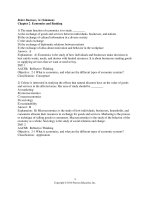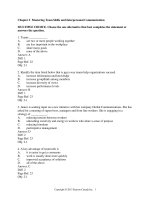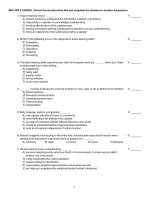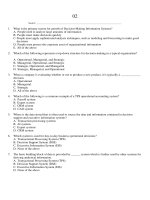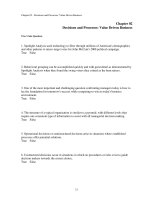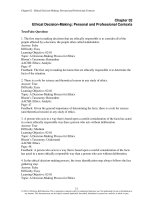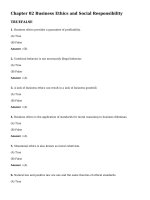Business continuity strategies protecting against unplanned disasters, 3rd edition
Bạn đang xem bản rút gọn của tài liệu. Xem và tải ngay bản đầy đủ của tài liệu tại đây (651.87 KB, 213 trang )
BUSINESS CONTINUITY
STRATEGIES
BUSINESS CONTINUITY
STRATEGIES
PROTECTING AGAINST UNPLANNED DISASTERS
3rd Edition
KENNETH N. MYERS
JOHN WILEY & SONS, INC.
This book is printed on acid-free paper. ∞
Copyright © 2006 by John Wiley & Sons, Inc. All rights reserved.
Published by John Wiley & Sons, Inc., Hoboken, New Jersey.
Published simultaneously in Canada.
No part of this publication may be reproduced, stored in a retrieval system, or transmitted in any form
or by any means, electronic, mechanical, photocopying, recording, scanning, or otherwise, except as
permitted under Section 107 or 108 of the 1976 United States Copyright Act, without either the prior
written permission of the publisher or authorization through payment of the appropriate per-copy fee to
the Copyright Clearance Center, Inc., 222 Rosewood Drive, Danvers, MA 01923, 978-750-8400, fax
978-646-8600, or on the web at www.copyright.com. Requests to the publisher for permission should
be addressed to the Permissions Department, John Wiley & Sons, Inc., 111 River Street, Hoboken, NJ
07030, 201-748-6011, fax 201-748-6008, or online at />Limit of Liability/Disclaimer of Warranty: While the publisher and author have used their best efforts in
preparing this book, they make no representations or warranties with respect to the accuracy or
completeness of the contents of this book and specifically disclaim any implied warranties of
merchantability or fitness for a particular purpose. No warranty may be created or extended by sales
representatives or written sales materials. The advice and strategies contained herein may not be
suitable for your situation. You should consult with a professional where appropriate. Neither the
publisher nor author shall be liable for any loss of profit or any other commercial damages, including
but not limited to special, incidental, consequential, or other damages.
For general information on our other products and services, or technical support, please contact our
Customer Care Department within the United States at 800-762-2974, outside the United States at 317572-3993 or fax 317-572-4002.
Wiley also publishes its books in a variety of electronic formats. Some content that appears in print
may not be available in electronic books.
For more information about Wiley products, visit our Web site at www.wiley.com.
Previous editions are as follows:
Total Contingency Planning for Disasters: Managing Risks, Minimizing Loss, Ensuring Business
Continuity, ISBN 0-471-15379-6.
Manager’s Guide to Contingency Planning and Disasters: Protecting Vital Facilities and Critical
Operations 2nd Edition, ISBN 0-471-35835-X.
Library of Congress Cataloging-in-Publication Data
Myers, Kenneth N., 1932–
Business continuity strategies : protecting against unplanned disasters / Kenneth N. Myers.
p. cm.
Rev. ed. of: Manager’s guide to contingency planning for disasters. 2nd ed. c1999.
Includes index.
ISBN-13: 978-0-470-04038-6 (cloth)
ISBN-10: 0-470-04038-6 (cloth)
1. Crisis management. 2. Strategic planning. 3. Risk assessment. I. Myers, Kenneth N., 1932–
Manager’s guide to contingency planning for disasters. II. Title.
HD49.M93 2006
658.4'056—dc22
Printed in the United States of America
10 9 8 7 6 5 4 3 2 1
2006046217
To Marcia
CONTENTS
About the Author
Preface
1
2
xv
xvii
Defining the Problem
1
Business Continuity Concerns
Telephone Communications
Computer Processing
Vital Facilities
Only a Computer Recovery Plan
Current Program May Not Work
Characteristics of a Sound Program
Cost-Reduction Opportunities
How to Contain Program Development Costs
Where to Look for Cost Reductions in an Existing Computer Disaster
Recovery Plan
Audit Concerns
Involving Department Managers
Need for Cost-Effective Solutions
Backup
1
1
2
6
7
8
9
10
12
Workplace Violence
21
Background
What Is Workplace Violence?
Who Is Vulnerable?
Contributing Factors
Liability
Employer Liability
Security
21
21
21
22
22
22
23
vii
14
16
17
18
19
viii
3
Contents
Workplace Violence Incidents
Three Stages Prior to Workplace Violence
Prevention
Policy and Strategy
Workplace Violence and Boards of Directors
Reducing Exposure to Workplace Violence
What Can Employers Do to Protect Employees?
How Can Employees Protect Themselves?
Warning Signs of Violence
Performance Indicators
Employee Training
Supervisory Training
Alternate Dispute Resolution
Incident Response Team Training
Incident Response
Critical Incident Stress Debriefing
Recommendation
24
25
25
25
26
26
27
27
28
28
29
29
30
30
31
31
32
Final Reports of the Federal Building
and Fire Investigation of the World Trade Center Disaster
33
Introduction
Genesis of This Investigation
November 29, 2005 Report Recommendations
Increased Structural Integrity
Recommendation 1
Recommendation 2
Recommendation 3
Enhanced Fire Endurance of Structures
Recommendation 4
Recommendation 5
Recommendation 6
Recommendation 7
New Methods for Fire-Resistant Design of Structures
Recommendation 8
Recommendation 9
Recommendation 10
Recommendation 11
Improved Active Fire Protection
Recommendation 12
Recommendation 13
Recommendation 14
Recommendation 15
33
33
34
36
36
37
38
39
39
41
42
43
44
44
45
46
47
48
48
49
50
51
Contents
4
ix
Improved Building Evacuation
Recommendation 16
Recommendation 17
Recommendation 18
Recommendation 19
Recommendation 20
Improved Emergency Response
Recommendation 21
Recommendation 22
Recommendation 23
Recommendation 24
Improved Procedures and Practices
Recommendation 25
Recommendation 26
Recommendation 27
Recommendation 28
Education and Training
Recommendation 29
Recommendation 30
Looking Forward
52
52
53
54
55
56
57
57
58
59
60
61
61
62
63
64
65
65
66
67
New Contingency Program Paradigm
69
Background
Strategies versus Plans
Terrorist Incidents
Terrorism, Workplace Violence, and Boards of Directors
Old Paradigm
Organizational Responsibility
Foreign Corrupt Practices Act
Common Mistakes
Computer Oriented
Systemic Problems
New Paradigm
Mind-Set
Organizational Responsibility
Terrorism
Facility Oriented
Workplace Violence
Contingency Program Components
Transitioning to the New Paradigm
Organizational Responsibility
Policy and Strategy
Development of Interim Processing Strategies
69
69
70
70
71
71
71
72
72
74
75
75
75
75
75
76
76
78
78
78
79
x
5
Contents
Developing a Contingency Program
Management’s Responsibility
How Much Market Share Could Cost You?
Protect Against What?
Contingency Planning Requires Specialization
Increased Technology Dependency
Corporate Issue
Contingency Program Phases
Prevention
Incident Recovery
Interim Processing
Discretionary Expense
Project Planning
Policy and Strategy
Limit Scope
Limit the Time Periods
Surgical Process
Game Plan
Team Concept
Prototype Programs
Awareness Education
Business and Environment
Types of Disasters
Potential Impact on Business
Program Objectives
Insurance Considerations
How Much Detail?
Establishing a Firm Foundation
Key Result Areas
Convincing Others
Executive Briefings
Business Impact Analysis
Objective
What Is Really Critical
Awareness and Education
Regulatory Agency Reporting Requirements
Window
Selecting a Methodology
Philosophy
Setting the Stage for Success
Program Requirements
Program Development Steps
Key Tasks
81
81
81
82
83
84
85
85
87
87
88
89
90
90
91
92
93
94
101
103
104
104
104
105
108
112
115
116
117
119
122
124
124
126
127
129
130
131
131
133
135
136
137
Contents
6
7
xi
Developing “What If” Interim Processing Strategies
Computer Processing Alternatives
Documentation
Cost Benefits
Corporate Benefits
Implementation
Tailor Presentations
Role of Senior Management
Role of a Steering Committee
Role of Department Managers
Role of First-Line Supervisors
Role of Outside Specialists
Develop Program with First-Line Supervisors
Obtain Department Managers’ Approval
Noncomputerized Business Functions
Maintenance and Testing
Objectives
Maintenance
Continuing Education and Preparedness Reviews
Technology Testing
139
140
144
150
152
154
154
155
155
156
157
158
158
165
165
167
167
167
168
169
Guidelines for Developing Contingency Programs
at Multiple Locations
173
Background
Objectives and Scope
Section I: Organization
Placement of Contingency Planning Activity
Organizational Functions
Section II: Standards for Implementation Planning
Methods Standards
Performance Standards
Section III: Standards for Developing Interim Processing Strategies
Methods Standards
Performance Standards
Section IV: Documentation Standards
Methods Standards
Performance Standards
Section V: Standards for Ongoing Maintenance and Testing
Methods Standards
Performance Standards
173
173
174
174
175
176
176
178
179
179
181
182
182
185
186
186
188
Conceptual Business Continuity Strategies
for Loss of Computer Operations
189
xii
Contents
Policy and Strategy
Policy
Strategy
Executive Summary
Normal Operations
Emergency Response
Interim Processing
Maintenance and User Continuing Education and Preparedness
Reviews
Glossary
Index
189
189
189
190
190
190
191
191
195
197
ABOUT THE AUTHOR
Kenneth N. Myers is an internationally recognized contingency planning specialist and educator. He has developed business continuity
strategies for leading organizations in the United States, Europe, Mexico, and Puerto Rico. Mr. Myers developed the curricula and was the
course leader for business continuity strategies to protect against
unplanned disasters seminars for The Battelle Institute and The American Management Association and was called to consult with the
largest tenant in the World Trade Center following its bombing. In this
book, he presents a new contingency program paradigm reflecting
the latest in contingency strategies development thinking as well as the
impact of terrorism and workplace violence on business continuity
needs. He is also the author of Manager’s Guide to Contingency Planning for Disasters: Protecting Vital Facilities and Critical Operations
and Total Contingency Planning for Disasters: Managing Risk . . .
Minimizing Loss . . . Ensuring Business Continuity.
xiii
PREFACE
The increase in terrorism and workplace violence has emphasized the
need to develop business continuity strategies to protect against
unplanned disasters.
Kenneth Myers, one of the foremost innovators and educators in
contingency planning, presents a new contingency program paradigm
urging boards of directors to take a proactive role in insisting organizations institutionalize policies aimed at preventing workplace violence. Mr. Myers documents employer workplace violence liabilities;
describes the three stages of conduct prior to a workplace violence
incident; and recommends supervisory training to prevent workplace
violence.
Mr. Myers explains why many existing disaster recovery plans are
inordinately detailed and too costly to fund and maintain. He also presents a methodology for transitioning to a contingency program that is
more cost-effective and more realistic. He also describes why Human
Resources is the discipline best positioned to develop and administer
business contingency programs.
This book presents organizations that have multiple locations with a
template for planning, developing, and administering contingency programs consistent in purpose, scope, strategy, and level of detail. It also
provides guidelines and controls to contain development costs and to
ensure low-cost interim processing strategies, consistent with the low
probability of a disaster.
Mr. Myers also documents 30 recommendations by the National
Institute of Standards and Technology (NIST) following an investigation
xv
xvi
Preface
of the collapse of the World Trade Center in New York City. These recommendations address: increased structural integrity; enhanced fire
endurance; improved fire resistance; increased fire protection; improved
emergency response; and improved evacuation procedures for mobilityimpaired building occupants.
Business Continuity Strategies: Protecting Against
Unplanned Disasters, 3rd Edition
By Kenneth N. Myers
Copyright © 2006 by John Wiley & Sons
1
DEFINING THE PROBLEM
BUSINESS CONTINUITY CONCERNS
Common areas of exposure to a disaster for a business include:
•
•
•
•
Telephone communications
Computer processing
Vital facilities
Critical operations
Telephone Communications
Telephones are often taken for granted; they are seldom out of service
except for brief periods, such as immediately following a storm. Older
electromechanical telephone switching equipment was extremely reliable. However, consumer demand for more sophisticated service has
resulted in a conversion from electromechanical to software-controlled
switching systems. The advantage of such systems is that they are easily modified to provide more sophisticated options to customers. The
downside is increased vulnerability to periodic interruptions in telephone service owing to software malfunction. Every time computer
software is changed, the risk of error increases—error that may lie dormant for months until the weakness is exposed. Moreover, it is unrealistic to expect all software changes to be sufficiently tested to preclude
failure. Many of the features are new, and models for testing are, by
definition, incomplete. Therefore, it is appropriate to prepare a contingency program that will provide minimum voice communication capability during a stabilization period.
1
2
Business Continuity Strategies
Computer Processing
Financial service organizations cannot operate for more than a day or
two without computer processing, as they need this capability to service transactions.
Yet for many other organizations, this is not the case. Although many
businesses are dependent on computers for day-to-day operations, it is
incorrect to assume that they could not operate without this support during a relatively brief disaster recovery period that might last a week or
two. The difficult part is focusing on the right issue—keeping the business running, rather than keeping the computer running.
Operating without Computer Processing Capability
Manufacturers can be exposed to several problems if computer processing is inoperable. However, careful analysis usually concludes that
although inefficient, product still can be manufactured and shipped
without normal computer processing support. Alternate interim processing strategies and prerequisites for manufacturing without normal
computer support need to be negotiated with functional managers. Prerequisites, such as starting points, need to be included in the contingency program to ensure that they will be available when needed. For
example, it is not that storeroom inventories cannot be updated without
an on-line computer; the problem is lack of a “starting point” or, in
other words, a record of what the inventory file looked like when the
computer outage occurred. So if a prevention program includes daily
responsibility to store off-site a duplicate copy of the storeroom inventory file, immediately following a computer disaster the file could be
printed at another location and delivered to manufacturing as a snapshot of inventory locations and availability. Receipts and disbursements could easily be updated with a simple personal computer (PC)
spreadsheet until normal computer processing is restored. See Exhibit
1.1 for vital manufacturing support functions.
Headquarters operations can also be exposed to problems if computer
processing is suddenly inoperable. However, careful analysis again usually concludes that although inefficient, business still can continue and
customers can still be serviced without normal computer processing support. It helps to look at administrative business functions and what alternatives are available to get the job done without computer processing.
Defining the Problem
3
EXHIBIT 1.1 Vital Manufacturing Support Functions
•
•
•
•
•
•
•
•
•
Take orders
Schedule production
Order material
Receive and store material
Control inventory
Pick items
Manufacture
Ship
Invoice
Insurance providers are concerned about issues such as new business underwriting; determining “in force” for claims adjudication;
beneficiary information; and exposure for coverage that would have
been canceled under normal circumstances. In each of these instances,
there are alternative strategies that, although inefficient and cumbersome, can be used to ensure business continuity until computer processing is restored.
Distributors need strategies for taking and processing orders that are
normally entered into computer databases, identifying kitting requirements, producing picking documents, inventory management, producing shipping documentation, and handling returns. The question to be
asked is not “What problems would you have?”; it is “If confronted
with this situation, what would you do to maintain market share and
service customers until normal operations resume?”
Associations and agencies are concerned about membership services, legislation and public policy, publications, research, education
and training, call centers, and government regulations. In most
instances, the overriding consideration is to seek solutions for operating temporarily without normal computer processing capability that
will not require continual funding, such as a computer hot-site agreement, but would ensure continuity in servicing members, volunteers,
and staff during a stabilization period.
Interim processing strategies for meeting administrative responsibilities without normal computer support need to be negotiated with
department managers. The window of expected outage must be determined. For the most part, information systems managers consistently
4
Business Continuity Strategies
agree that they could restore computer processing capability within 10
working days (14 calendar days). So the question to be asked of
department managers is not “How long can you do without . . .” or
“What do you need . . .”; managers tend to understate and pad the first
question, and in response to the second question tend to ask for more
than they need. Both questions beg answers and initiate thought
processes that are not conducive to cost-effective contingency programs and invite discussions and deliberations that require further documentation and maintenance expense. The only question to ask line
managers in relation to doing without normal computer processing is
“What alternate strategies could be used to continue functioning for
approximately ten days without computer processing capability?”
When that question is asked, 99 percent of the responses are positive,
that is, department managers are willing to accept operating at less
than 100 percent efficiency and admit what could be done to meet the
challenge of temporarily working without computer processing.
The simple psychology and willingness of contingency planners to
“stick their necks out” and insist on establishing a reasonable limit to
an expected computer outage will, in turn, have the positive effect of
persuading line managers to admit how they could survive. Establishing this “window” up front is the key to a collaborative solution.
But also remember that in establishing the window, information systems managers must also accept some risk and not pad their expected
recovery capability. The question is not “When are they absolutely
positive beyond any reasonable doubt that computer processing will
be restored?”; rather, it is “Given emergency conditions, working 24
hours a day, seven days a week, with adequate resources, when is it
likely that computer processing could be restored?” On-line connectivity can wait because there are other solutions available, but being
able to process data is the important requirement. See Exhibit 1.2 for
a list of typical administrative business functions.
Computer processing problems could be caused by a myriad of conditions. Power grids could fail due to unanticipated drops in demand
(as users of questionable systems delay initializing operations, either
because corrective work has not been completed or because of other
concerns) which are so severe that the power companies must bring
down and reconfigure power systems grids nationally. Failures of
Defining the Problem
5
EXHIBIT 1.2 Typical Administrative Business Functions
•
•
•
•
•
•
•
•
•
•
Inventory management
Order processing
Scheduling
Billing
Receivables
Payables
General accounting
Payroll
Human resources
Data processing
satellite communications, HVAC (heating, ventilation, air conditioning, and cooling) systems, automated processing equipment, and computer hardware or software are all possible. The broad and diversified
nature of this potential problem is such that testing cannot ensure that
some systems might not fail.
One-time potential problem issues have two dimensions. The first
is to identify steps that need to be taken to reduce the likelihood of
computer-dependent operations from being interrupted and monitoring compliance with those programs, within reason. Without careful
oversight by informed senior management, this approach can wind up
being a boondoggle for consulting firms—fear tactics, an inordinate
amount of “analysis” and “weigh it by the pound” reports, endless
meetings, and a large consulting bill.
Most important, however, is to develop a fallback plan that will ensure
business continuity even if computer-dependent operations are temporarily inoperable. Experience and common sense suggest that a fallback plan is the safety net that needs to be in place, and organizations that
already have a facility contingency program already have one. It just
needs to be dusted off and modified slightly, and it can easily be used as
a fallback plan. Conversely, if an organization does not already have a
contingency program for loss of computer processing, now is the time to
prepare one because it will solve both problems. Chances are that if there
are failures, they will be isolated and will be corrected in a matter of days,
if not hours. See Exhibit 1.3 for a fallback plan development strategy.
6
Business Continuity Strategies
EXHIBIT 1.3 Computer Processing Fallback Plan Development Strategy
•
•
•
•
Identify computer-dependent vendors and services.
Identify business functions dependent on computer processing.
Fund and monitor a prevention program.
Obtain senior management’s approval of a corporate policy and strategy for a
fallback plan.
• Develop “what if” interim processing strategies for all potentially affected
business functions to protect market share and support customer service, even
if normal computing capability is not available for a few days.
• Add a prevention program.
• Add an incident recovery plan.
Vital Facilities
The loss of buildings resulting from fire and other accidents is not a
new threat. Nor are there any miraculous solutions. Insurance is still the
most cost-effective answer. Business failure following a disaster is normally caused by a loss of assets, such as a manufacturing facility, distribution center, or office building, or an inability to support vital
business functions following a disruption in normal processing capability. An inability to support vital business functions immediately following a publicized disaster can be devastating when this information is in
the hands of competitors. If orders are “lost,” customer service communications lines are inoperable, or inventory availability records become
unreliable, even if only for a few days, it can result in a significant loss
of market share, particularly with the 20 percent of a company’s customers who make up 80 percent of its revenue. Most organizations have
not adequately addressed the issue of how to keep the business running
if a plant or office building is inaccessible for several days. In other
words, the concern is not what to do if assets are destroyed, but how to
continue to operate a business if primary work locations are temporarily inaccessible or unusable.
In many production and manufacturing facilities, losing normal computer processing capability would have a serious impact on efficiency,
order processing, scheduling, and tracking orders, but it would not
destroy the ability to somehow manually shepherd product through the
manufacturing and shipping process. Efficiency would suffer; record
Defining the Problem
7
keeping would become a nightmare, excess inventory would have to be
ordered (and worked off later) to avoid stock-outs, and production rates
would drop, but product would get out the door.
Losing access to an entire production facility or one critical operation could, in many instances, bring manufacturing to a halt. Without
alternate solutions to ship product until operations return to normal,
business failure could result. It is this possibility and its impact on cash
flow that demands that companies have contingency programs for loss
of normal computer processing capability and “what if” strategies for
a temporary loss of access to production facilities.
Raw material and component parts might be sent to alternate manufacturing sources; components might be purchased instead of manufactured; excess regional production capacities might be temporarily
leased; “second-choice” production alternatives might be approved;
inspection and quality control procedures might be changed; and some
items might be shipped direct. The important issue is for manufacturing managers to take the time to “think through” which alternatives are
most likely to work and which are most cost-effective. It is important
that these alternate production methods or “what if” strategies be documented in writing so that: (1) their workability can be validated annually; (2) any prerequisites, such as maintaining daily backup copies of
inventory status reports or files off-site to support alternate manufacturing methods, can be identified and inserted into a prevention plan;
and (3) crisis management activities, such as using the most recent
stock status reports as a basis for insurance claims, are added to the
incident recovery plan.
Only a Computer Recovery Plan
Which comes first, the chicken or the egg? Which comes first in contingency planning? Recovering lost technology or keeping the business running? The business continuity program should come first. In
fact, data processing plans to recover technology that are developed
before interim processing strategies are explored normally result in an
excessive amount of resources committed to redundant computer processing capability. Auditors are becoming increasingly critical of the
lack of business continuity programs and are beginning to emphasize
8
Business Continuity Strategies
this area more than the loss of computer processing technology. After
all, what good is a restored computer if users are unable to keep the
business running immediately following a disaster? If you are just getting started in contingency planning, you should address the business
continuity issue before you worry about redundant computer processing capability.
Current Program May Not Work
Less than 25 percent of business organizations have a workable contingency program. Some programs look good on paper—but would not
work if they had to be implemented. Programs that are not viable usually have three things in common:
1. The focus is on keeping the computer running rather than on
keeping the business running.
2. No one has taken the time to identify alternate procedures to
support functions that normally rely on computer technology
but could actually survive a stabilization period using alternate
methods.
3. The program contains unnecessary detail and professes to cope
with problems that are typically nonexistent.
Exhibit 1.4 lists common reasons why many contingency programs
will not work.
EXHIBIT 1.4 Common Disaster Recovery Plan Problems
• Focus on recovering computer technology at costly hot sites, rather than on
sustaining business continuity until temporary computer processing capability
can be restored locally
• Lack an awareness and education program that enables functional managers
to understand the importance of their input and are willing to participate in
program development
• Do not explore alternate procedures that could sustain vital business functions
(that normally are dependent on centralized computer processing) until
computer processing capability is restored
• Provide excessively detailed procedures when guidelines are all that are needed
Defining the Problem
9
CHARACTERISTICS OF A SOUND PROGRAM
A contingency program should be reviewed annually to ensure compatibility with business practices and to integrate lessons learned from
new disasters and test results into more cost-effective solutions. Many
times it is helpful to have someone other than the individual who
developed the program to conduct such a review. It is difficult to be
objective when reviewing your own work.
A corporate contingency program approved by senior management
is a requirement. This document should emphasize that (1) providing
100 percent redundancy for all types of physical disasters is simply not
practical; (2) documenting detailed alternate procedures for an infinite
number of combinations of possible disasters is also not realistic and
would create a “monster” to maintain; and (3) departmental managers
are the architects of “what if” interim processing strategies that will
serve as guidelines to ensure business continuity following a disaster.
Assumptions under which a program is developed should be stated
to clarify expectations and avoid excessive documentation. Examples
of assumptions include:
•
•
•
•
•
Qualified personnel will be available to execute the program.
Healthcare agencies and institutions will be operational.
A building evacuation plan exists.
Inefficiencies are expected during a stabilization period.
Incoming telephone calls will be rerouted within two hours.
A prevention program should reflect disaster prevention responsibilities; ongoing education and training requirements; testing programs;
other sound risk management practices; and any additional measures
required to support relocation strategies, interim processing strategies,
or technology restoration plans. The primary purpose of a prevention
program is to reduce the likelihood of a disaster, such as physical security programs, and to take steps that will minimize impact, such as storing computer files off-site, if a disaster does occur.
An incident response plan should ensure an organized response to a
facility-related disaster and provide for the rapid rerouting of incoming
10
Business Continuity Strategies
phone calls and a strategy for restoring computer processing capability.
It also includes relocation strategies, minimum staff required during a
stabilization period following a facility disaster, notification for personnel and customers, damage assessment, and media management.
Interim processing strategies, in the absence of other instructions,
will be used to maintain business continuity if facilities become inaccessible following a facility disaster. Emphasis is on retaining market
share, servicing customers, and maintaining cash flow. Business continuity strategies should have been developed by discussions with
department managers familiar with existing business practices and
alternative options. These strategies should also include functioning
without normal computer support (computer operations may not be
restored for days) and with minimum staff if relocation is needed.
COST-REDUCTION OPPORTUNITIES
The most costly mistake that a business can make in developing its
program is to have it aimed at keeping technology running instead of
keeping the business running (Exhibit 1.5 provides an action plan for
cost savings). Contingency programs that are not cost-effective usually
have three characteristics:
1. Program focus is on keeping technology running rather than on
keeping the business running.
2. No one worked with functional supervisors to develop alternate
procedures to support vital business functions until normal processing capability is restored.
3. The program fails to recognize that businesses could continue to
function for a week or two without normal computer processing
capability.
Cost-reduction opportunities exist due to individual mistakes that
alone sound innocuous but, in combination with other related mistakes, spell bad financial judgment. First, an error in interpretation
of the Foreign Corrupt Practices Act by accounting firms led to criticizing clients for “lack of a computer disaster recovery plan.” That
criticism was misdirected. What was actually needed was interim
Defining the Problem
11
EXHIBIT 1.5 Action Plan for Cost Savings
• Initiate a cost reduction project.
• Have outside specialists (other than those who developed the existing plan)
conduct a plan evaluation.
• Focus only on sustaining cash flow and servicing customers during a disaster
recovery period.
• Deal with business functions, never with computer systems.
• Work with functional line managers and first-line supervisors to analyze
options.
• Develop cost-effective guidelines that will sustain vital business functions.
processing strategies to be used in the event of a disruption in normal
data processing technology. Placing undue emphasis on computer
technology, instead of business continuity, was the mistake. Because
the focus was on the wrong issue, it led organizations to assign project responsibility to the wrong department. Had the objective been
business continuity, project responsibility might have been assigned
to a staff person positioned to facilitate a strategic plan. However,
with the focus on computers, responsibility was assigned to data processing personnel, who are normally not trained in the synergistic
process used to develop strategic programs.
In many instances, these errors resulted in technical solutions being
substituted for sound business judgment because the situation was
defined as a computer problem that needed a computer solution. The
result for many organizations has been excessive expenditures for
redundant processing. Taken over a period of 20 to 30 years, this
amounts to millions of dollars being wasted. Exhibit 1.6 provides a
brief synopsis of why cost-reduction opportunities exist.
EXHIBIT 1.6 Why Cost-Reduction Opportunities Exist
• Initial program focused on getting the computer running quickly at costly
computer hot sites rather than waiting a few more days to restore operation at
a cold site
• Plan development responsibility assigned to data processing rather than to a
staff position
• Lack of specialized problem-solving process that continually links the low
probability of occurrence with the need for cost-effective solutions
12
Business Continuity Strategies
How to Contain Program Development Costs
Minimizing contingency program development costs centers on five
interconnected issues: (1) plan development sequence, (2) mind-set,
(3) assumptions, (4) communications, and (5) a specialized problemsolving process. If any are missing or not dealt with appropriately,
development costs will be excessive, the end product will not be of
good quality, and it will take forever to complete the project.
Plan development sequence means positioning and selling senior
management on a corporate contingency planning policy and strategy,
and documenting this corporate policy and strategy in writing before any
other activities are undertaken in the program development process. If
this is not the first step, then problem-solving practices are used, which
are totally inappropriate. For instance, conducting a “business impact
analysis” to determine what is critical under normal conditions is unproductive. A definition of critical is needed. In a contingency planning
context, critical is not what receives the highest priority under normal
operating conditions because we are not worried about operating under
normal conditions. We are concerned about which business functions
will be so impaired as to threaten business continuity following a disaster
because they lack alternate strategies to operate under those conditions.
What is critical at the time a physical disaster occurs depends on what
alternative strategies can be used to support that business function. If a
particular business function has alternative methods to service customers
for a two-week period when computer processing is inoperable, then
there is nothing critical because business continuity is not threatened.
The worst mistake is to begin a contingency program project by
developing a computer recovery plan based on an assumption that the
business could not operate for two weeks without normal computer
support and that prioritizes application recovery based on the wrong
definition of critical, as described in the last paragraph. It takes someone with seasoned contingency program experience to prevail in establishing the proper development sequence. The benefit, however, is that
a program can be completed in 30 days and at a fraction of the cost.
Mind-set is the philosophy under which a contingency program is
developed, and failure to document the proper mind-set in a corporate
contingency planning policy and strategy will result in false starts, lack


